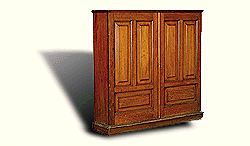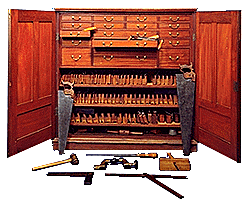
![]()
Mahogany Tool Chest
By Arthur Sorrill; West Bromwich, England; ca. 1894; 130 x 132.5 cm. CMC D-4819
Craft traditions introduced into Canada from Europe have evolved over many generations. The woodworker's trade continued to be passed on from father to son, or from master to apprentice, and the tools remained much the same; but adaptations were necessary to work new materials and to meet people's changing needs. For example, woodworkers became more specialized as their markets expanded, some working only as carpenters, coopers or wheelwrights, and others as cabinet-makers, chair-makers or even sculptors.

All used the species of wood most suitable for the objects they were making: the cooper selected ash and white oak to make watertight barrels, the chair-maker preferred cherry and white ash for their toughness and elasticity, and the cabinet-maker used pine, cherry, ash, maple and walnut for a wide variety of products. It is the furniture-maker who has given us the most eloquent examples of the woodworker's art — armoires with plain or diamond-point panels, elaborate desks, buffets and chests of drawers, and elegant chairs modelled after the latest European styles.
Arthur Sorrill of Bromwich, England, made this mahogany tool chest around 1894, when he was only 19. Most of the tools it contains also date from that period and were manufactured in England. In the tradition of woodworkers, Arthur Sorrill passed his tools and his trade on to his son, William, who used both here in Canada.

